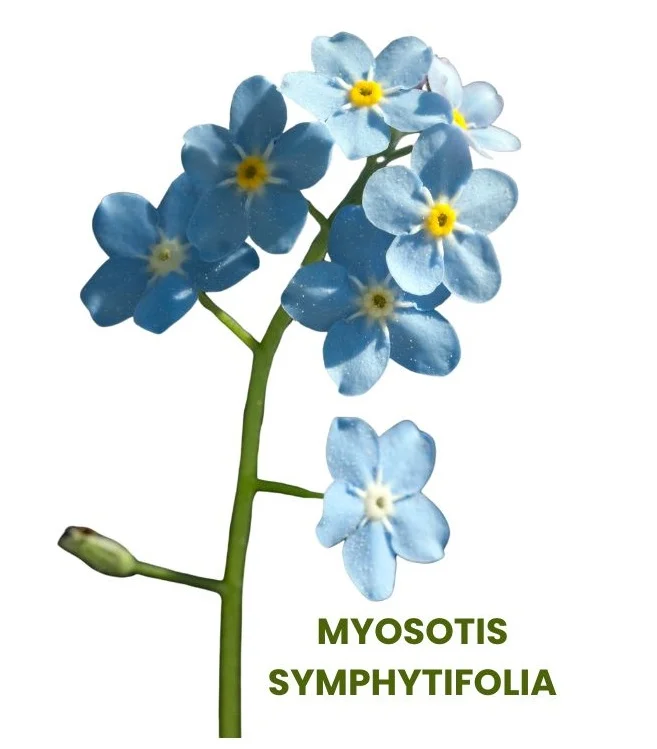Myosotis Symphytifolia, commonly known as Forget-me-not, is a homeopathic remedy primarily used for chronic respiratory conditions such as bronchitis and phthisis (tuberculosis).
This remedy is also known for addressing symptoms like night sweats.

SOURCE INFORMATION
Scientific Classification
- Kingdom: Plantae
- Clade: Angiosperms
- Order: Boraginales
- Family: Boraginaceae
- Genus: Myosotis
- Species: Myosotis symphytifolia
Origin and Historical Facts
- Origin: Myosotis symphytifolia is a species of the genus Myosotis, commonly found in Europe and parts of Asia.
- It thrives in moist environments, often near streams and wetlands.
- Historical Facts: The name “Forget-me-not” originates from ancient times and is associated with various legends and folklore.
- It has been used traditionally in herbal medicine for its purported benefits in treating respiratory ailments and other conditions.
DRUG PATHOGENESIS
- Myosotis Symphytifolia primarily acts on the respiratory system, providing relief for chronic bronchitis and symptoms associated with tuberculosis.
- It helps in reducing cough and associated expectoration, alleviating night sweats, and relieving pain in the lungs.
KEY CHARACTERISTICS
- Respiratory Relief: Effective in treating chronic bronchitis and tuberculosis.
- Night Sweats: Helps in reducing excessive sweating at night.
- Expectoration: Manages cough with profuse muco-purulent expectoration.
DETAILED ORGAN SYMPTOMS
RESPIRATORY SYMPTOMS
- Cough: Persistent cough with abundant muco-purulent (mucus and pus) expectoration.
- The cough can cause gagging and vomiting, and it worsens while or after eating.
- Bronchorrhea: Excessive discharge of mucus from the bronchi.
- Lung Pain: Pain in the left lung, particularly in the lower part.
- The pain is noticeable during coughing and is sensitive to touch or percussion.
GENERAL SYMPTOMS
- Night Sweats: Excessive sweating during the night, often associated with chronic respiratory conditions.
MODALITIES
- Worse: While eating, after eating, and during coughing.
RELATIONSHIP WITH OTHER DRUGS
- Compare: Remedies used for similar respiratory conditions like Bryonia, Phosphorus, and Drosera.
- Complementary: Remedies that support chronic respiratory ailments and night sweats.
DOSE
- Potency: Administered in tincture form to the second potency.
- Administration: Dosage and frequency should be determined by a qualified homeopathic practitioner based on individual symptoms and response.
Frequently Asked Questions (FAQs)
What conditions can Myosotis Symphytifolia treat?
- Myosotis Symphytifolia is effective for chronic bronchitis, tuberculosis, and night sweats associated with respiratory conditions.
How does Myosotis Symphytifolia help with respiratory issues?
- The remedy helps alleviate persistent cough, reduce excessive mucus production, and relieve pain in the lungs.
What are the key symptoms indicating the need for this remedy?
- Key symptoms include a persistent cough with muco-purulent expectoration, night sweats, and pain in the lower left lung that is sensitive to touch.
How should Myosotis Symphytifolia be administered?
- Myosotis Symphytifolia can be administered in tincture form or up to the second potency, depending on the symptoms and the recommendation of a qualified homeopathic practitioner.
Meaning of Difficult Words
- Phthisis: Tuberculosis.
- Muco-purulent: Containing both mucus and pus.
- Bronchorrhea: Excessive discharge of mucus from the bronchi.
- Expectoration: The act of coughing up and spitting out mucus or other fluids from the respiratory tract.
- Percussion: A diagnostic technique in which the surface of the body is tapped to determine the condition of the underlying tissue based on the sound produced.
- Tincture: A solution of a medicinal substance in an alcoholic solvent.
- Potency: The strength of a homeopathic remedy, indicated by the degree of dilution.
